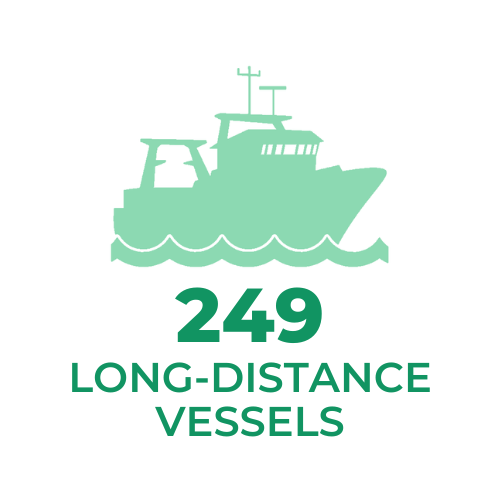1. WHAT DO WE TALK ABOUT WHEN WE TALK ABOUT “LONG-DISTANCE FLEET”?
The EU “Long-Distance fleet”, often also called “Distant-water fleet” (DWF), comprises fishing vessels above 24 metres flying the flag of an EU member state and fishing outside of EU waters (“other fishing regions”). This excludes the Mediterranean but includes EU’s outermost regions. This fleet represents only 0.5% of the 73,600 EU active vessels but carries out 15% of all the landings of the EU in weight and in value.
Over the years, the number of DWF vessels has decreased (from 366 in 2008 to 249 in 2020), however, this has not impacted the level of catches and landings, which has remained the same and, some years, even increased.
2. Where do Distant Water VESSELS fish?
Any fish caught by a vessel flying an EU member state flag is considered a catch of this EU member state even if fished in waters outside the EU, either high seas or the Exclusive Economic Zone of third countries.
High Seas
Half of the EU catches from external waters are fished in the high seas. As stipulated by the United Nations Convention of the Law of the Sea (UNCLOS), the high seas are the waters that are not part of “the exclusive economic zone, in the territorial sea or in the internal waters of a State, or in the archipelagic waters of an archipelagic State.”[1]
In these waters, EU vessels are mostly interested in highly migratory species, mainly tuna. The management of tuna fisheries is regulated by regional bodies, called Regional Fisheries Management Organisations (RFMOs), covering the vast geographical areas of these highly migratory species. The European Commission plays an active role in 6 tuna and 11 non-tuna RFMOs. However, in terms of numbers, EU vessels are mostly fishing in the areas managed by the RFMOs ICCAT (Atlantic Ocean) and IOTC (Indian Ocean).
Exclusive Economic Zones of third countries
The other half of the catches made outside EU waters is fished in the Exclusive Economic Zones of third countries (comprised in the area from the shore to 200 nautical miles).
Approximately 80% of these catches come from the EEZ of third countries engaged with the EU in a Sustainable Fisheries Partnership Agreement (SFPA). SFPAs with third countries are signed when EU vessels want to fish in their EEZ because as stipulated by UNCLOS, these countries assume the jurisdiction over the exploration and exploitation of marine resources in these 200 nautical miles and the adjacent section of the continental shelf[2]. The rest of catches in EEZs (20%) without an SFPA is possible via private agreements between the Government of the third country and a particular fishing company.
3. WHAT IS THE LDAC?
The Long Distance Fleet Advisory Council (LDAC) is an EU fisheries stakeholder body, providing advice to the European Institutions (Commission, Council and Parliament) and EU Member States on SFPAs, relations with RFMOs in which the EU is a contracting party, or with international organizations in whose waters the EU Fleet operates, as well as trade policy and international market for fish products.
The LDAC has more than 50 members representing the different interests in the sector, from the fishing industry, the unions, and environmental and development NGOs. As a member and vice-president of the LDAC, CFFA promotes the rights and interests of coastal communities in third countries in the decision-making process.
The body’s permanent secretariat has an office in Madrid and is funded by the European Commission, as all other advisory bodies, but also by the Spanish Ministry of Fisheries, Spain being the Member State with the most vessels active in distant waters.
For more information
Fishing authorization lists (Note: Click on the link below the title “list of authorizations”)
Sources
Scientific, Technical and Economic Committee for Fisheries (STECF) - The 2020 Annual Economic Report on the EU Fishing Fleet (STECF 20-06), EUR 28359 EN, Publications Office of the European Union, Luxembourg, 2020, ISBN 978-92-76-27164-2, doi:10.2760/500525, JRC123089, pages 33, 49.
European Commission, “Fishing outside the EU,” available at: https://ec.europa.eu/fisheries/cfp/international_en
United Nations Convention of the Law of the Seas, 1982. Available at: https://www.un.org/depts/los/convention_agreements/texts/unclos/unclos_e.pdf
Note: With regards to the data, we have aimed to select the most updated from the STECF report, which even though published in 2022, has data up to 2020 and nowcasts up to 2022. Note that data from 2019 and 2020 was heavily impacted by Covid-19 and related restrictions. For purposes of better portraying some of the dimensions of the Long-Distance fleet we have also taken information posted on the European Commission website, which might be less updated.
References
[1] Article 86, UNCLOS.
[2] Articles 56-57, UNCLOS.







